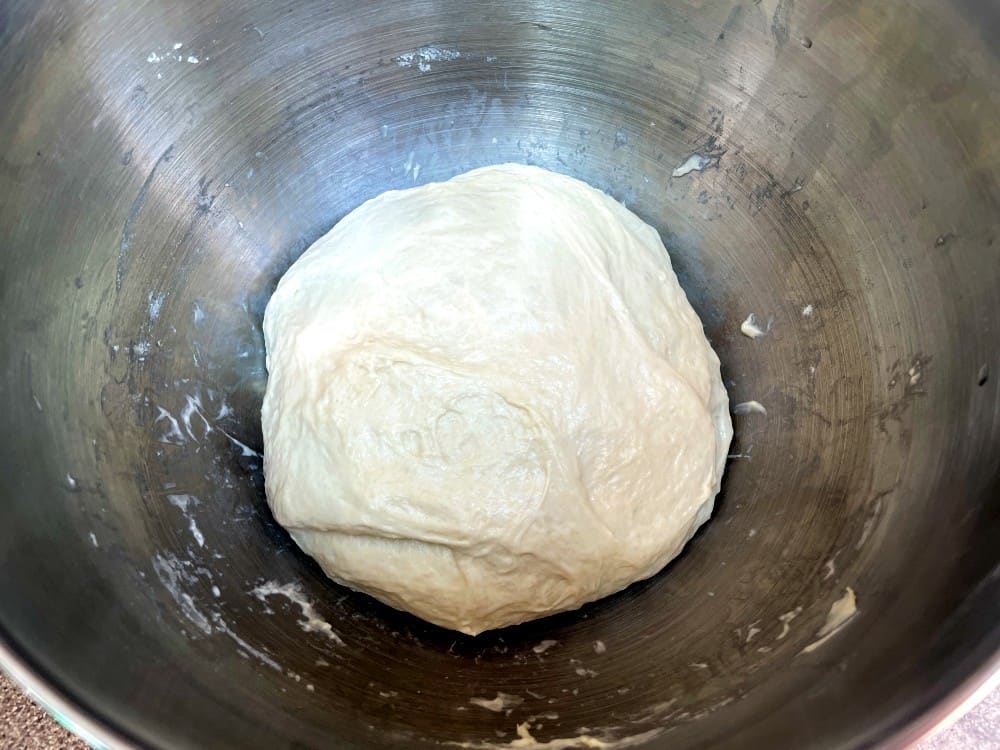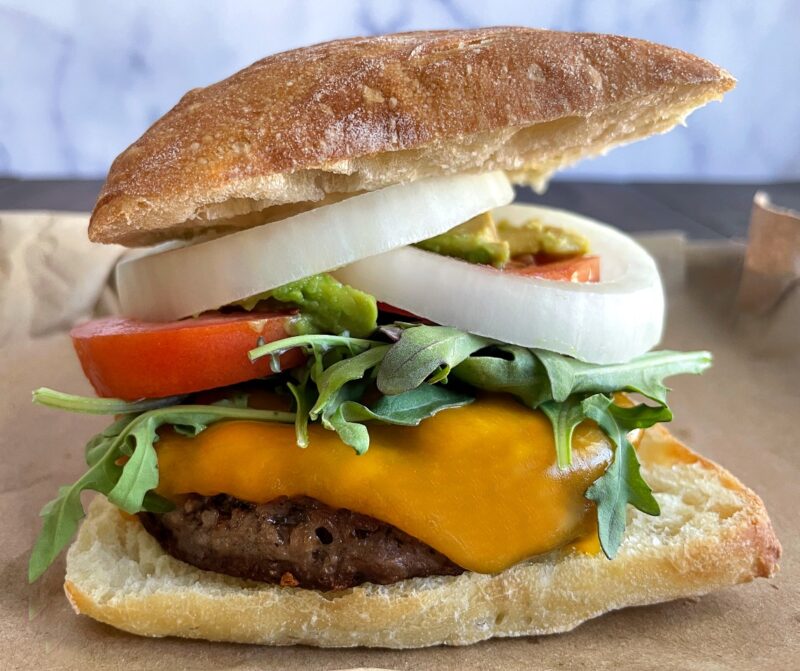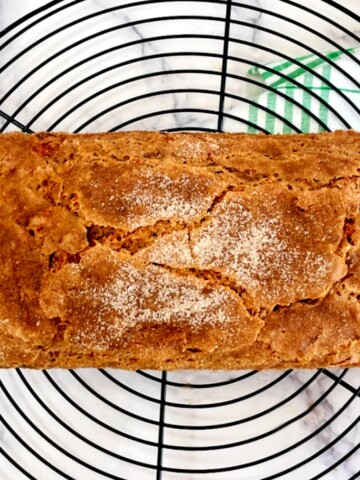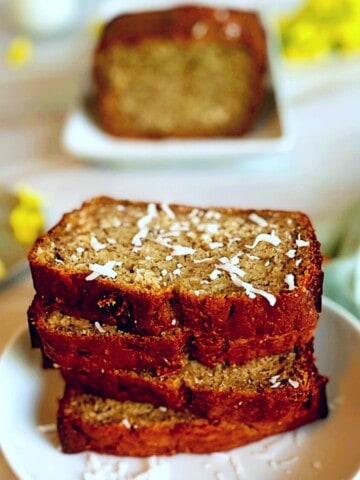This Easy Ciabatta Rolls Recipe can be made in one day and takes about 4 hours from start to finish. With only 4 ingredients, these ciabatta rolls can be made whenever you need a roll or bun for burgers, sandwiches, and more!

Jump to:
Why You Will Love This Recipe
If you need rolls or buns for your meal, make this Easy Ciabatta Rolls Recipe. This is a great recipe for beginner bread makers, similar to my No-Knead Rosemary Bread and my Dutch Oven Sourdough Bread, and the only hard part is waiting for the dough to rise. Instant yeast does most of the work to create bubbly and delicious bread just like in my Greek Pita Bread.
What is Ciabatta Bread?
Ciabatta bread is an Italian bread known for its distinctive shape, airy texture, and crispy crust. It originated in the northern regions of Italy, particularly in the area surrounding Lake Como.
Ciabatta starts with sticky and wet dough and turns into a bubbly creation once it's been folded a few times and stretched to a rectangle. I'll walk you through the steps and you'll be enjoying your fresh, homemade ciabatta rolls in no time!

Ingredients Needed to Make This Recipe

- Water: Water is an essential component of ciabatta bread dough. It provides hydration to the flour, allowing the gluten strands to develop and resulting in a soft and elastic texture. Water also contributes to the formation of steam during baking, which helps create a crispy crust.
- Instant Yeast: Instant yeast, also known as rapid-rise or bread machine yeast, provides leavening to the dough, causing it to rise and develop air pockets, resulting in the characteristic open crumb of ciabatta bread.
- Flour: All-purpose flour is used in this recipe to provide structure and strength to the dough. The protein in the flour helps develop gluten, which contributes to the bread's texture and chewiness. You can also use bread flour.
- Salt: Kosher salt adds flavor to the bread and also helps regulate the fermentation process. It strengthens the gluten structure, improving the texture and overall quality of the bread.
*See the recipe card for the complete list of ingredients and quantities.
How to Make Ciabatta Rolls

Step 1: Activate the Yeast - Mix the warm water and yeast in a large mixing bowl and let the mixture sit for 8-10 minutes to activate the yeast.

Step 2: Create a Shaggy Dough - Add the flour and salt and stir everything together. Cover the bowl with plastic wrap and allow it to sit for 1 hour.

Step 3: Fold and Stretch the Dough - Wet your hands and fold and stretch the dough four times. Cover the bowl with plastic wrap and rest for 30 minutes. Repeat this step 2 more times.

Step 4: Stretch the Dough - Gently remove the dough from the bowl onto a lightly floured surface. Carefully stretch the edges of the dough ball out to make a rectangle about ¾" thick or so.

Step 5: Create Smaller Rectangles - Using a scraper/chopper or a sharp knife, cut the rectangle into 5-6 even-sized squares. Place the squares on a piece of parchment paper, cover them with a towel or plastic wrap, and allow to rest one more time for 40 minutes.

Step 6: Bake The Rolls on a Baking Stone - Preheat the oven and the baking stone at 420°F. Boil 2 cups of water and place a pan or bowl with the boiling water at the bottom of the oven to create steam. Bake the rolls for 20 minutes and then remove them to cool on a rack.
Expert Tips For This Recipe
- High Hydration Dough: Ciabatta dough is a high-hydration dough. This helps develop those classic holes in the bread. Don't panic if your dough is sticky and wet in the beginning.
- Wet Hands: Keep your hands wet when handling the sticky dough during the folding process. This prevents excessive sticking and keeps the dough moist.
- Parchment Paper: Parchment paper helps prevent the dough from sticking during baking. You can place the parchment paper right on the baking stone to prevent sticking.
- Steam in the Oven: Adding a bowl or pan of boiling water is a key step in the baking process. This creates steam in the oven to keep the ciabatta rolls chewy but crispy on the outside. It also helps create a beautiful brown color.
- Cooling Properly: Ensure you allow the ciabatta rolls to cool completely on a wire rack. This will help maintain the texture and avoid a gummy center.
- Dry Climate: If you live in a dry climate, you may need to add a little more water in step 2 to ensure the dough is wet, sticky, and shaggy-looking. Add 1 tablespoon at a time until you are satisfied with the texture.
What to Use These Rolls For
Because of the airy interior and lightly crunchy exterior of these rolls, ciabatta can be used for many things. Due to its versatility and light texture, ciabatta bread is commonly used for sandwiches, particularly paninis, as its structure allows it to hold fillings without becoming too dense or overwhelming the flavors. Here are some other ideas:
- Burgers (shown below)
- French Toast or French Toast Casserole
- Toast for breakfast
- Dip in olive oil and balsamic vinegar
- Croutons
- Bread for soup like my Roasted Heirloom Tomato Soup

Recipe FAQs
The best way to bake ciabatta rolls is on a baking stone in the oven lined with parchment paper.
If you don't have a baking stone you could use a cast iron skillet, a Dutch oven, or a heavy-duty baking sheet. If you use a cast iron skillet or Dutch oven, you will have to bake the rolls in batches.
Yes, these buns can be frozen. Ensure they have fully cooled before wrapping them in plastic wrap and placing them in a freezer-safe sealable bag or container. They will last in the freezer for up to 3 months. Enjoy!
Tools Needed For This Recipe
A baking stone is a must-have to get a good crunchy crust on your ciabatta rolls. I use the round version because I also like to make pizza on it and the rectangle version is nice because it's a little larger and easy to maneuver bread on.
The other tool I highly recommend is a bench scraper to help with forming the bread and cutting your rolls.
More Bread Recipes To Check Out
If you get a chance to make these Easy Ciabatta Rolls, tag me on Instagram or Facebook and show me, or leave a review below! You can also follow me on Pinterest and sign up for my e-mail list to receive more fun and delicious recipes in your inbox.

Easy Ciabatta Rolls
Equipment
- baking stone
- cast-iron pan or oven-safe pan/bowl
- scraper/chopper
- plastic wrap
Ingredients
- 1 cup warm water 240 grams, (room temp, not too hot)
- 1 teaspoon instant yeast 3 grams
- 2½ cups all-purpose flour 300 grams, (properly measured)
- 1 teaspoon kosher salt 6 grams
Instructions
- Place the warm water and yeast in a large mixing bowl and mix together. Let the mixture sit for 8-10 minutes until there is some nice bubble action happening.
- Once the yeast is active, add the flour and salt and stir everything together. I use a silicone spatula which made scraping the sides and bottom of the bowl easier. The dough will be wet and sticky and a little shaggy. Cover the bowl with plastic wrap and allow it to rest for 1 hour. TIP: I placed mine in the oven with a bowl of hot water, but you can also leave it on the counter if it's warm enough in your house.
- After an hour, wet your hands and fold and stretch the dough four times all the way around the dough. Pull up two corners, stretch lightly and fold over the top of the dough ball. Repeat this 2 more times. Cover the bowl again with the plastic wrap and rest for 30 minutes. Repeat this step 2 more times for a total of 3 stretch and fold sessions and an hour and a half of additional resting time.
- By now the dough should have doubled in size and be nice and bubbly. Carefully remove the dough from the bowl onto a lightly floured surface. TIP: lightly flour the top of the dough and your hands for easier transfer. Carefully stretch the edges of the dough ball out to make a rectangle about ¾" thick or so. Try not to squish the dough or all of that air you worked so hard to create inside will get out.
- Using a scraper or a sharp knife, cut the rectangle into 5-6 even-sized squares. Place the squares on a piece of parchment paper, cover with a towel or plastic wrap and allow to rest one more time for 40 minutes. While the dough is proofing a final time, preheat the oven and baking stone at 420°F. You can preheat the oven for the full 40 minutes to ensure your oven is nice and hot. About 15 minutes before the end of final proofing, boil 2 cups of water and place an oven-safe pan or bowl with the boiling water at the bottom of the oven and to the side so the steam has a chance to reach the bread.
- Once the dough has rested for 40 minutes, carefully transfer the parchment paper with the dough squares onto the baking stone. You can also have the paper and dough on a baking sheet and place the baking sheet right on top of the baking stone. Bake for 20 minutes and then remove the rolls and place them on a cooling rack to cool.
Video
Notes
- Ciabatta dough is a high-hydration dough. This helps develop those classic holes in the bread. Don't panic if your dough is sticky and wet in the beginning.
- Keep your hands wet when handling the sticky dough during the folding process. This prevents excessive sticking and keeps the dough moist.
- Parchment paper helps prevent the dough from sticking during baking. You can place the parchment paper right on the baking stone to prevent sticking.
- Adding a bowl or pan of boiling water is a key step in the baking process. This creates steam in the oven to keep the ciabatta rolls chewy but crispy on the outside. It also helps create a beautiful brown color.
- Ensure you allow the ciabatta rolls to cool completely on a wire rack. This will help maintain the texture and avoid a gummy center.
- If you live in a dry climate, you may need to add a little more water in step 2 to ensure the dough is wet, sticky, and shaggy-looking. Add 1 tablespoon at a time until you are satisfied with the texture.
Nutrition
Any nutrition calculations are only estimates using online calculators. Please verify using your own data.











Sarah says
Delicious and easy to follow recipe
Emily says
Thanks, Sarah, I'm so glad you enjoyed it!
Mary Benford says
everything turned out great but just wanted to make you aware that when you increase the recipe, the US measurements increase but the grams do not. I thought something was off when I doubled the recipe for five cups of flour and it still said 300 g.
Emily says
Hi Mary, thanks for letting me know, I'll try to find out what's going on with the conversion. Enjoy your ciabatta rolls!
Jose says
Mary I am not an expert in fact I am new to baking but what I have done is multiply by 2 every ingredient individually if it says 300 g of flour I use 600 g and so for the water if it says 240 g I use 480 g see and the same for the yeast and salt, that way you keep the same hydration ratio of the recipe, in this case is 80 %, in actuality I do the opposite since I am learning I shrink the recipe since I am learning in case I do something wrong I don’t waste too much Dow see, try it and see, obviously you have to learn to read the Dow (that for me is o was the most difficult part in baking) and adjust see, hope this helps.
Jota says
How many grams are 1 cup of flour? and how many grams are 1 cup of water?
Emily says
Hi Jota,
1 cup of flour: Approximately 120 grams or 4.25 ounces.
1 cup of water: Approximately 240 grams or 8.1 ounces.
Keep in mind that the weight of flour can vary slightly depending on how it is measured (scooped vs. spooned into the cup).
Enjoy!
Jota says
thank you Emily, 😊
Maroonmango says
Perfection! Just finished making these for the first time and they looked so good we couldn't wait for supper to be done to try them. They're a hit with the whole family. I saw someone ask if they can be doubled (of course after already doing so) and I have to say they came out wonderfully. Definitely will be in our regular rotation. Thank you so much!!
Emily says
Thank you so much!! And thanks for letting us know doubling the recipe was no problem. I hope you and your family enjoy many more of these ciabatta rolls!😁
Robin St. John says
I’ve been wanting to try ciabatta for a long time as it’s one of my favorite breads. This. Was. Excellent! Hands down my favorite bread bake ever. Thank you for the perfect recipe and directions. Really outstanding. I will make this again and again….
Emily says
Thanks, Robin!! That makes my day ☺️ Happy bread baking!
Dani says
I love the cabata rolls at Costco!! These are even better!! They turned out perfect, chewy and fluffy. Thank you! Does doubling the recipe work? sometimes it is not quite the same. These take a lot of work for 6 rolls, but they are worth it! I am definitely saving this recipe.
Emily says
Hi Dani, I'm so glad you loved this recipe! I have not doubled this recipe, however, I don't think you will have an issue since it's fairly small to begin with. Let me know if you give it a try!
Lee-Ann Kelly says
Just made these rolls and they are cooling so can't comment on the taste yet but they smell lovely. I have a question - my rolls are pretty pale and not as nicely browned as yours. How do I get that lovely golden colour on the crust?
Emily says
Hi Lee-Ann, thanks for trying out the recipe! Did you place a bowl of water at the bottom of your oven? You can also light spray the rolls every 10-20 minutes with a fine mist of water to try and achieve a darker color on top or move them a step closer to the heating element in you oven. Just make sure you keep an eye on them so they don’t burn. Enjoy!
Kim says
Hi, I made these a couple of weeks ago and they turned out absolutely perfect. 1st time I have ever had success with a yeast bread! I am just making them now and they were about 30 minutes into the 1st rise, and I realized that they were not as sticky looking as they were the 1st time period. Somehow I missed the video but watched it just now and realized they should have been stickier. Is it too late to add a little water into it now?
Emily says
Hi Kim,
Sorry, I am just seeing this so it might be too late...however, it's pretty tricky to add ingredients after the dough has started proofing or resting so I'm not sure if you would have been successful or not. After an hour you were prob out of luck sadly. Did you keep going with the recipe? Sometimes the dough will come together after all. Now that you are seeing success with bread making, hopefully, you will keep at it and continue to learn what to look for as you go. I still run into issues from time to time but get better at knowing what I want my dough to look like and when to make small adjustments. Thanks for trying the recipe and good luck!
Phyllis says
Made these buns and very pleased with results! Can you freeze these buns?
Emily says
Hi Phyllis, I'm so glad you like them. Yes, these buns can be frozen. Ensure they have fully cooled before wrapping them in plastic wrap and placing them in a freezer-safe sealable bag or container. They will last in the freezer for up to 3 months. Enjoy!
Rearatwa says
what can I use if I don't have a baking stone?
Emily says
Hi, you could use a cast iron skillet, a dutch oven, or a heavy-duty baking sheet.
Stephen Price says
Made two batches one for me and one for my son so easy and so delicious making another batch today thanks for the recipe.
Emily says
Thanks, Stephen, I'm so happy to hear that you are loving this recipe. Enjoy!
Risa says
These came out perfect. Crusty and light. Great addition to a shrimp salad.
Emily says
That's wonderful. Thanks for the review, Risa!
Pessy Weber says
Your recipe is the best the rolls were fabulous can I just make one loaf of bread in a Dutch oven instead of the rolls thanks
Emily says
That's wonderful, Pessy! Thanks for trying my recipe and letting me know how it went.
Jasmin says
How long did you bake the bread in the dutch oven? Do you always put parchment paper down when cooking bread in a dutch oven?
Emily says
Hi Jasmine, I bake my rolls on a baking stone in the oven. I believe one of my readers used a dutch oven. I'm not sure how long she baked it. I personally always use parchment paper in my dutch oven when I am baking bread in it. Removal and clean-up are so much easier!